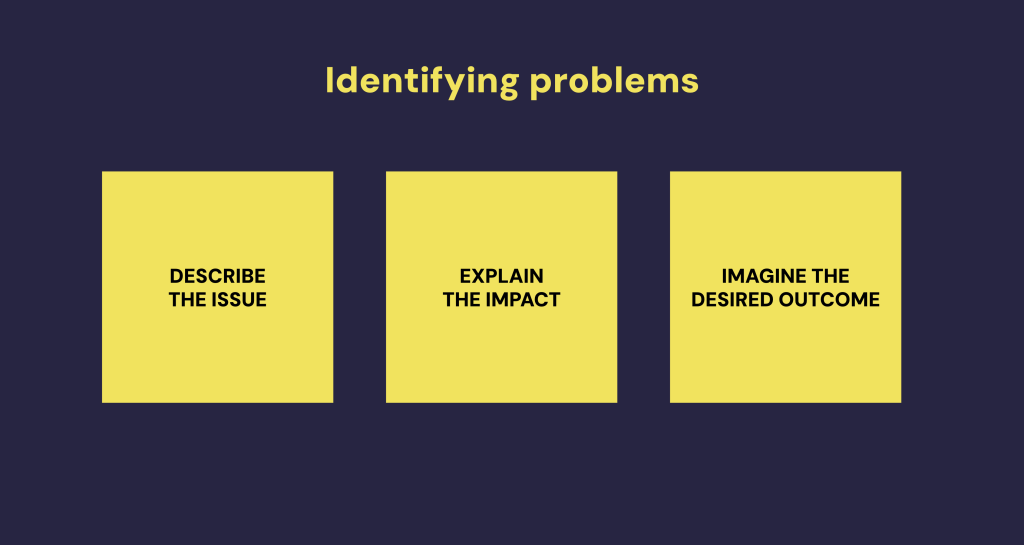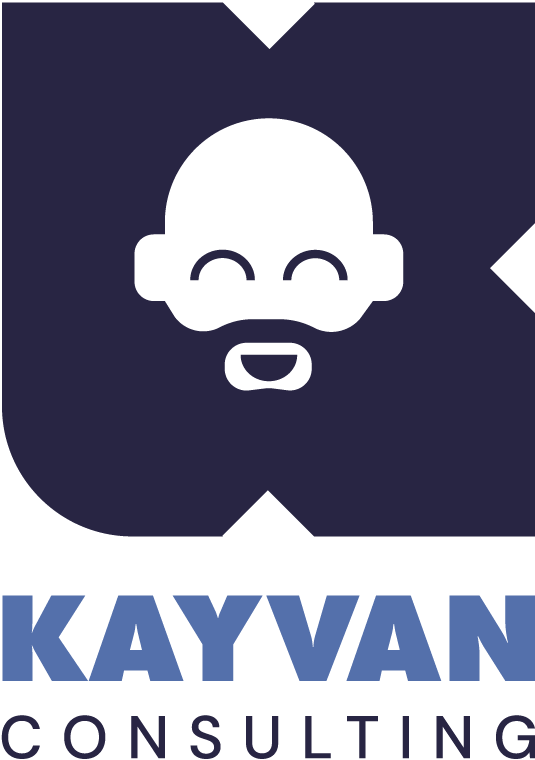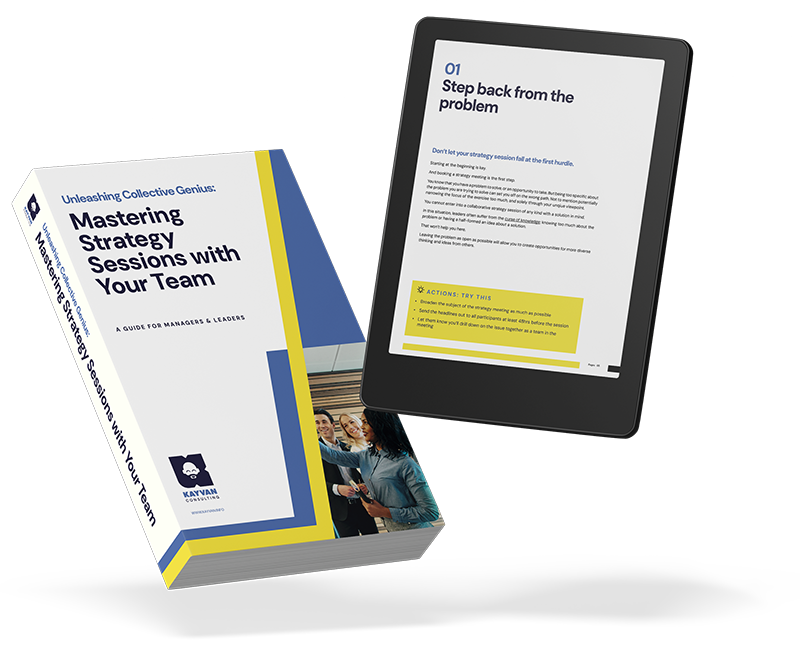Table of Contents
As someone who champions people-first business strategies, I’ve often seen the impact of empowering employees by introducing a team problem-solving framework.
These kinds of processes are more commonly found in engineering or product teams. But there is a compelling argument for bringing a practical, simplified framework into any working environment where a team is collaborating. The payoff breeds a multitude of positives:
- Teams get into a rhythm of identifying issues
- A culture of problem-solving can be developed
- Increased transparency & accountability
- Reduction of issues for management to deal with
For leaders who don’t want to micromanage, yet need solutions for addressing ongoing challenges without overwhelming their already full agenda, this sounds like a godsend, right? That’s why I’m sharing this team problem-solving framework with you – a simple yet powerful approach tailored to encourage collaboration and innovation while seamlessly integrating into daily operations.
Problem solving and teamwork go hand in hand. But not without some effort in getting things set up correctly. As a leader, it’s your responsibility to identify tools for team problem-solving and introduce them.
This article was born from a real-world issue that a client of mine was having. They were seeing repeated mistakes, issues, and inefficiencies cropping up across their (admittedly small) but growing team. While I was working on helping them improve onboarding & documenting their internal processes, they needed a mechanism for addressing these issues. Sending emails, chat messages, or raising a backlog of problems in regular one-to-ones with team members was becoming way too time-consuming.
So I built out this framework to help them leverage their wider team in solving issues collaboratively.
Read on to find out how collaboration helps teams solve problems and what steps you can take to bring this approach to your team.
What is a Team Problem-Solving Framework?
Think of a team problem-solving framework as your playbook for tackling challenges together. A problem solution framework lets you tap into your team’s collective intelligence and diverse viewpoints. Because let’s face it, when we tackle issues from all angles, truly transformative ideas can emerge.
This isn’t about passing the buck or relying on outdated management tactics where only leaders hold the keys to success. Instead, it’s about setting up an environment where everyone feels valued and empowered to spot inefficiencies or potential glitches early on. Get them out in the open, explain the context with as much transparency as possible, then fix them collaboratively before they become bigger roadblocks.
By utilizing this process-driven approach, you’re not just solving existing problems; you’re equipping everyone involved for valuable long-term growth both individually within roles and collectively across teams aligned towards organizational goals.
Developing collaborative problem solving skills in your team, then applying them in regular meetings when addressing challenges, will help everyone move towards achieving their shared team goals.

How Does a Culture of Problem-solving Drive Innovation?
You might be asking yourself, “Why is fostering a culture of problem-solving so integral to innovation?”
The truth is, when a team starts looking at problems not as obstacles but as opportunities, the potential for creative solutions multiplies.
Encouraging an open dialogue about challenges shines a light on inefficiencies that may otherwise stay hidden. When every team member feels safe to point out and discuss issues, you unlock a wealth of diverse perspectives. These insights can transform the way something is done – inevitably leading to fresh ideas and innovative paths forward.
Consider the ripple effect this kind of environment can create.
Teams that regularly engage in collaborative problem-solving become more adept and agile in their roles. They start to anticipate potential pitfalls, address them proactively, and collectively envision solutions that ensure smoother operations. This adaptability doesn’t just benefit the individuals; it elevates the entire organization’s ability to innovate and meet its goals.
By embedding team problem-solving activities into the fabric of your company or team culture, you uphold leadership accountability while also sparking organic innovation – a combination that can help your business not only survive but thrive in a competitive landscape.
Steps to Implement the Team Problem-Solving Framework
Setting up a team problem-solving framework doesn’t have to be overwhelming.
By breaking it down into manageable steps, you can seamlessly integrate this process into your operations, making it a natural part of your team’s workflow.
Please note though – this is a simple problem solving framework for identifying and solving smaller, day to day issues. There are a vast array of frameworks out there for solving big and tough problems. I’d personally recommend a more in-depth strategy workshop to address larger issues or complex problems – ideally facilitated by an expert.
1) Identify and Describe Issues Clearly
Start by encouraging team members to identify problems as soon as they arise. Make it a point to define each issue clearly – vague descriptions can only lead to confusion. The more specific you can be, the easier it will be for your team to develop effective solutions quickly. Clear articulation allows everyone to visualize the problem, setting a solid foundation for collective resolution.
2) Explain the Impact on Business Efficiency
When tackling problems, consider the broader impact on business operations. Highlight why each issue matters to the organization’s performance and efficiency – be it reduced operational costs, higher quality outputs, or improved customer satisfaction. You may need to describe what the impact on the business will be in the future if the issue is not resolved. This understanding keeps everyone motivated and aligned towards finding not just any solution, but the optimal one.
3) Establish Desired Outcomes and Goals
Next, focus on what you really want to achieve. It’s vital for your team to understand what the ideal scenario looks like and how achieving these goals aligns with business objectives. Defining these outcomes helps point the team in the right direction and prioritizes solving issues that truly matter.

Encourage Team-Driven Solutions
Finally, foster an environment where expressing potential solutions is just as welcome as stating problems. Encourage team debates and brainstorming sessions. Tapping into this collaborative spirit means ideas to fix the problems won’t only come from the top down; rather, they’ll burgeon organically from all corners of your team. Hence, empowerment grows throughout an entire organization – and solutions, often imaginative and inspiring, take root more efficaciously.

How to Foster a Culture of Collaboration and Accountability
Creating a workplace where collaboration flourishes and accountability is a shared value accelerates the problem-solving process. It starts with building trust among team members, encouraging open communication, and promoting shared values that prioritize mutual support over individual achievement.
Strategies for Building Trust and Transparency
A transparent culture doesn’t grow overnight, but strategic efforts can nurture it. Begin by establishing open communication channels – allowing everyone to express their thoughts comfortably and candidly. Consistent team check-ins help maintain awareness, where individuals willingly step up knowing they’re backed by their peers. This supportive atmosphere reinforces trust and ensures transparency becomes part and parcel of daily operations.
Emotional Intelligence and Psychological Safety
Developing problem-solving skills as a group also requires each individual to sharpen their own skills in the realm of emotional intelligence.
Having the bravery to put forward a new or different idea can feel scary for some team members, so leaders should seek to create an environment of psychological safety where possible. This might involve explaining the need for more dominant voices in the room to give space for a broader range of diverse perspectives approaching a problem.
Everyone needs to feel like they have permission from the whole group when it comes to identifying issues. Workplace diversity – not just in terms of the background of each individual, but in terms of their area of expertise in a variety of disciplines – can help in addressing challenges from different vantage points.
The Importance of Regular, Concise Team Meetings
While meetings might get a bad rap for being too numerous or time-consuming, they are pivotal when sculpted into concise, purposeful gatherings. Schedule regular brief meetings specially dedicated to the framework – spaces where team members can voice concerns, and propose ideas freely. Keeping discussions focused and action-oriented draws a line between productive engagement and time-consuming chatter.
Remember, accountability thrives when responsibilities are clear and acted upon promptly. Assign action items during these meetings with specific timelines, making accountability visible without descending into micromanagement.

Tools and Techniques for Effective Team Problem Solving Activities
Facilitating productive team meetings is a cornerstone of embedding a collaborative problem-solving framework. Utilizing the right tools and establishing structured routines are essential components.
Utilizing a Solutions Board Effectively
A solutions board is a great tool to visually capture ongoing issues and potential ideas. Whether it’s a physical board in your office or a virtual platform like a shared document or specific software, it should be accessible to all team members. Encourage everyone to post sticky notes or comments regarding challenges they notice, articulating:
- The issue
- An explanation of the impact it is having or will have in future
- The desired outcome
Having this visual representation allows the team to view problems collectively as opportunities for improvement. It promotes transparency and encourages members to contribute regularly – essentially creating a dynamic and open space for problem-solving.
Setting a Regular Cadence for Meetings
Consistency is pivotal to maintaining momentum. Establish a regular schedule for your meetings dedicated to reviewing this solutions board – whether weekly or bi-weekly, whatever best fits your team’s strategic needs.
Within these sessions, keep the focus tight. Allow for reviewing new and existing challenges, brainstorming innovative solutions, and following up on previously assigned action items. Efficiently managed meetings can transform seemingly isolated concerns into collective wins, reinforcing accountability and shared achievement.
Additionally, consider rotating the role of meeting facilitator among different team members. This practice empowers more voices, fresh perspectives, and emphasizes that everyone contributes to driving the team toward common goals. Channeling leadership qualities across your team not only supports growth but instills a sense of unity and collective responsibility.
Case Studies and Real-Life Examples
Implementing a team problem-solving framework isn’t just theoretical—it’s grounded in real-world success stories. Take, for example, a mid-sized tech company that faced recurring integration issues between development and operations teams. By adopting a solutions board and regular problem-solving sessions, they not only decreased system downtime but also improved cross-departmental collaboration. Employees reported higher satisfaction, inspired by their ability to directly influence operational outcomes.
Another example involves a retail chain struggling with supply chain inefficiencies. Through transparent problem identification and goal-setting meetings, they created efficient logistical solutions, enabling a 20% reduction in delivery times. The framework encouraged team-driven innovations that improved customer satisfaction significantly.
Conclusion: Transforming Teams with Problem-Solving Frameworks
Incorporating a team problem-solving framework into your business practice leverages the collective wisdom and creativity within your organization—transforming challenges into opportunities for growth.
This approach not only fosters a culture of problem-solving but also aligns individual contributions with larger organizational goals.
I invite you to take the first step: introduce the concepts of a solutions board at your next team meeting. Encourage open dialogue and allow your team to explore innovative solutions collectively. Over time, you’ll likely see not just improvements in how problems are solved, but also a shift in your business’s cultural mindset towards one of accountability, innovation, and shared success.
Remember, as you embark on this journey, adaptability and feedback are key. Fine-tune the framework to suit your team’s unique needs, and don’t hesitate to reach out for guidance or share your experiences. Together, we can build workplaces that champion creativity and growth in equal measure.
If you’re interested in collaborative problem solving training for your team, please feel free to contact me.
FAQs
What if my team is initially resistant to using the problem-solving framework?
Resistance can be common when introducing new processes. Start by clearly communicating the benefits of the framework, such as reduced workloads, shared responsibilities, and improved team dynamics. Engage your team in discussions, solicit their feedback, and consider their suggestions to customize the framework to better fit your team’s unique culture. Gradually incorporating these processes and demonstrating quick wins can help ease them into embracing this collaborative approach.
How can I ensure that the solutions board doesn’t become overloaded with problems?
Prioritization is key. Encourage your team to focus on high-impact issues by having a dedicated section for urgent matters on the board. It might also be useful to set time frames for each entry; if a problem hasn’t been revisited or resolved within a certain period, reassess its priority or seek a different perspective during your next meeting.
Is it necessary to have face-to-face meetings, or can these team problem solving activities work virtually?
The framework is versatile and can be adapted for both in-person and virtual environments. In today’s digital age, many tools like Slack, Trello, or dedicated project management software can seamlessly facilitate virtual solutions boards and meetings. The critical element is maintaining consistent, clear communication and engagement, regardless of the medium you choose.
How do I measure the success of implementing a team problem-solving framework?
Success can be gauged in several ways, including improved efficiency metrics, enhanced team collaboration, faster problem resolution times, and heightened job satisfaction. Regularly review these metrics and solicit feedback from your team to understand where adjustments may be needed.
What role should managers play in team problem solving activities?
Managers should act as facilitators and supporters rather than directors. Encourage teams to voice issues and propose solutions independently. A manager’s role is to guide the process, ensure alignment with organizational goals, and support team members by providing resources and removing obstacles.




